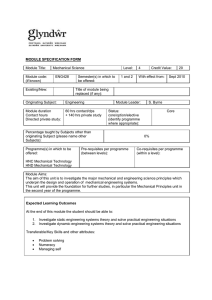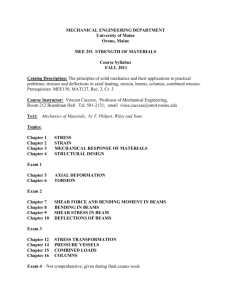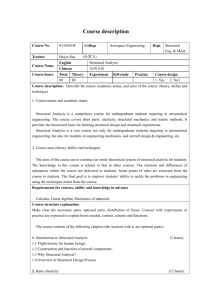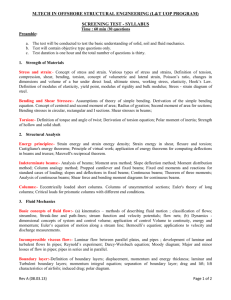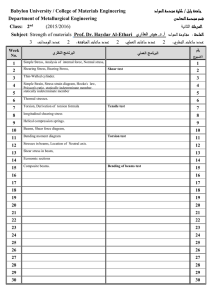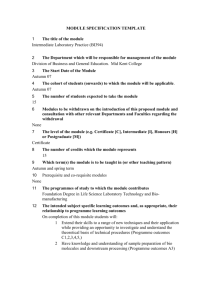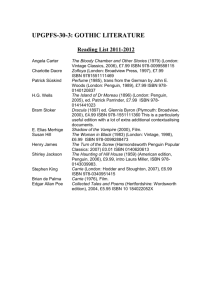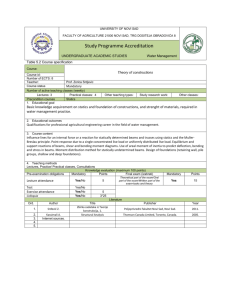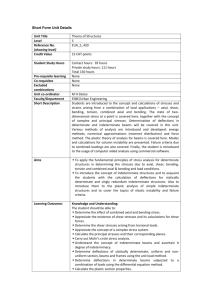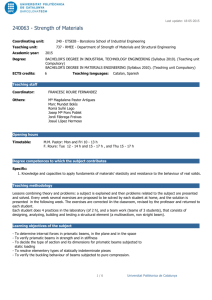University of Kent at Canterbury
advertisement
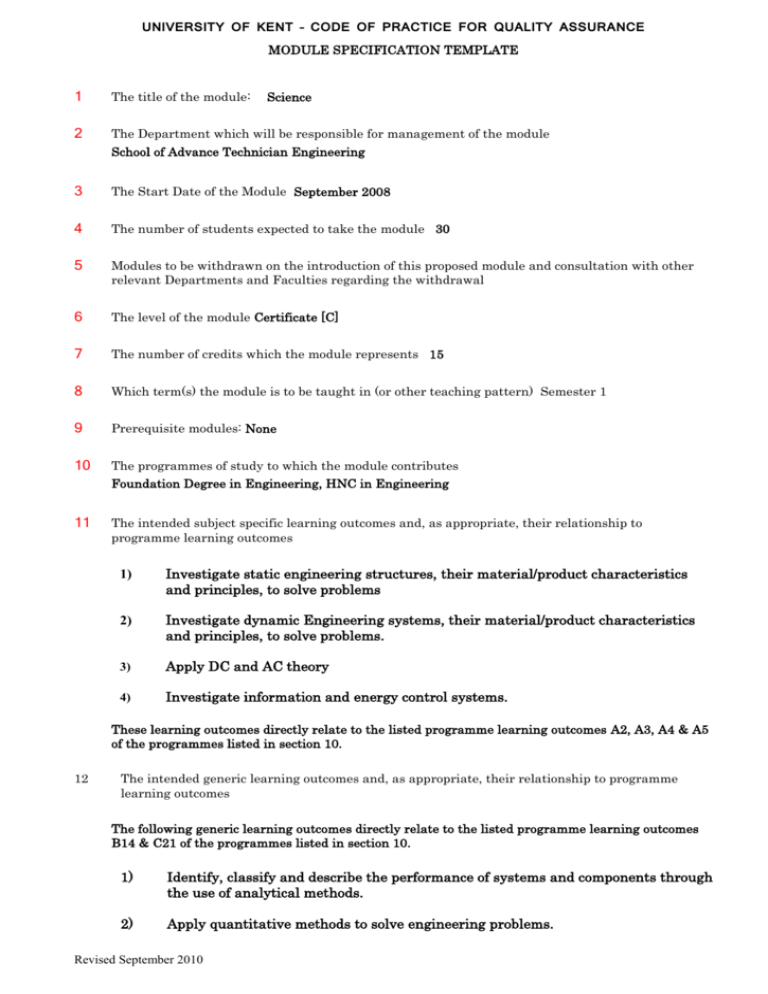
UNIVERSITY OF KENT – CODE OF PRACTICE FOR QUALITY ASSURANCE MODULE SPECIFICATION TEMPLATE 1 The title of the module: 2 The Department which will be responsible for management of the module Science School of Advance Technician Engineering 3 The Start Date of the Module September 2008 4 The number of students expected to take the module 30 5 Modules to be withdrawn on the introduction of this proposed module and consultation with other relevant Departments and Faculties regarding the withdrawal 6 The level of the module Certificate [C] 7 The number of credits which the module represents 15 8 Which term(s) the module is to be taught in (or other teaching pattern) Semester 1 9 Prerequisite modules: None 10 The programmes of study to which the module contributes Foundation Degree in Engineering, HNC in Engineering 11 The intended subject specific learning outcomes and, as appropriate, their relationship to programme learning outcomes 1) Investigate static engineering structures, their material/product characteristics and principles, to solve problems 2) Investigate dynamic Engineering systems, their material/product characteristics and principles, to solve problems. 3) Apply DC and AC theory 4) Investigate information and energy control systems. These learning outcomes directly relate to the listed programme learning outcomes A2, A3, A4 & A5 of the programmes listed in section 10. 12 The intended generic learning outcomes and, as appropriate, their relationship to programme learning outcomes The following generic learning outcomes directly relate to the listed programme learning outcomes B14 & C21 of the programmes listed in section 10. 1) Identify, classify and describe the performance of systems and components through the use of analytical methods. 2) Apply quantitative methods to solve engineering problems. Revised September 2010 UNIVERSITY OF KENT – CODE OF PRACTICE FOR QUALITY ASSURANCE 13 A synopsis of the curriculum Static engineering structures: Simply supported beams: shear force, bending moment and stress due to bending, radius of curvature, eccentric loading of columns, stress distribution; middle third rule; Beams and columns: elastic section modulus for beams; standard section tables for rolled steel beams; selection of standard sections. Torsion in circular shafts: theory of torsion and its assumptions, distribution of shear stress and angle of twist in solid and hollow circular section shafts. Dynamic engineering systems: Uniform acceleration: linear and angular acceleration; Newton’s laws of motion; mass moment of inertia and radius of gyration of rotating components; combined linear and angular motion; effects of friction. Energy transfer: gravitational potential energy; linear and angular kinetic energy; strain energy; principle of conservation of energy; work-energy transfer in systems with combine linear and angular motion; effects of impact loading. Oscillating mechanical systems: simple harmonic motion; linear and transverse systems; effects of forcing and damping. DC and AC theory: DC electrical principles: Ohm’s and Kirchoff’s laws; voltage and current dividers; analogue and digital signals; motor and generator principles; fundamental relationships. AC circuits: features of AC sinusoidal wave form for voltages and currents; other more complex wave forms produced from sinusoidal wave forms; R, L, C circuits; high or low pass filters; power factor; true and apparent power; resonance and resonant frequency; Qfactor: Transformers: high and low frequency; transformation ratio; current transformation; unloaded transformer; input impedance; maximum power transfer; transformer losses. Information and energy control systems Information systems: block diagram representation qualitative description of how electrical signals convey system information; function, operation and interfacing of information system components; effect of noise system output for a given input. Energy flow control systems: block diagram representation of an energy flow control system, qualitative description of how electrical signals control energy flow; function, operation and interfacing of energy flow control system components; system output for a given input; interfacing of appropriate energy flow control system components. Interface system components: identification of appropriate information sources; interface information system components/energy flow control system components. 14 Indicative Reading List Bedford A and Fowler W – Statics (Addison-Wesley, 1997) ISBN 0201403404 Bolton W – Mechanical Science (Blackwell Science, 1998) ISBN 0632049146 Hannah J and Hillier M – Mechanical Engineering Science (Longman, 1995) ISBN 0582326753 Hughes E – Electrical Technology (Prentice Hall, 2001) ISBN 058240519X Tooley M – Electronic Circuits Fundamentals and Applications (Newnes, 2001) ISBN 0750653949 Tooley M and Dingle L – Higher National Engineering (Butterworth-Heinemann, 1999) ISBN 0750646292 Revised September 2010 UNIVERSITY OF KENT – CODE OF PRACTICE FOR QUALITY ASSURANCE 15 Learning and Teaching Methods, including the nature and number of contact hours and the total study hours which will be expected of students, and how these relate to achievement of the intended learning outcomes The module is designed to offer a broad-base of study of key scientific principles, covering both mechanical and electrical concepts associated with the design and operation of engineering systems. It aims to provide the basis for further study in specialist areas of engineering. Students will be expected to spend 150 hours of study apportioned as follows: 50 contact hours: involving a mix of taught lessons to explain the theoretical and practical aspects of the module 20 hours assessment and revision 80 hours private study 16 Assessment methods and how these relate to testing achievement of the intended learning outcomes The module will be assessed by coursework only.. The coursework (100%) comprises four assignments. Each assignment will cover one of the four specific learning outcomes Each assignment will be equally weighted and comprise 25% of the course work marks..………….. Subject specific learning outcomes 1) Investigate static engineering structures, their material/product characteristics and principles, to solve problems 2) Investigate dynamic Engineering systems, their material/product characteristics and principles, to solve problems. 3) Apply DC and AC theory. Revised September 2010 Assessment Criteria Calculate the distribution of shear force, bending moment and stress due to bending in simply supported beams. Use the material and product characteristics to select standard rolled steel sections for beams and columns to satisfy given specifications,. Use relevant scientific principles and methodology to calculate the distribution of shear stress and the angular deflection due to torsion in circular shafts. Use mathematical principles to calculate the behaviour of dynamic mechanical systems in which uniform acceleration is present. Use mathematical principles to calculate the effects of energy transfer in mechanical systems. Use engineering principles and apply them to analyse the behaviour of oscillating mechanical systems. Analyse and solve problems in DC electrical principles using the appropriate methods. Describe a variety of complex wave forms and explain how they are produced from sinusoidal wave forms. Solve problems on single phase R, L, C circuits and components. Solve problems on transformers using AC theory. Use appropriate computer software packages to UNIVERSITY OF KENT – CODE OF PRACTICE FOR QUALITY ASSURANCE confirm solutions to DC and AC theory problems 4) Investigate information and energy control systems. Describe the method by which electrical signals convey information. Analyse an information system. Describe the methods by which electrical signals control energy flow. Identify, classify and describe the performance of energy control system by means of analysis methods and modelling techniques. Interface system components to enable a chosen system to perform the desired operation. 1) Identify, classify and describe the performance of systems and components through the use of analytical methods. Use analytical methods and modelling techniques. 2) Apply quantitative methods to solve engineering problems. Resolve engineering problems using appropriate methods. Generic Learning Outcomes Implications for learning resources, including staff, library, IT and space. This module will be taught and supported by appropriately qualified lecturers who have experience in supervising research projects. All the items stated in the Indicative Reading List are available at the Medway Campus, Learning Resource Centre IT suites which all allow Internet, On-line T.I. Onestop Technical Index Facility. Practical sessions will take place in the Electrical and Mechanical Labs which are fully equipped to accommodate the requirements of learning outcomes. A full-time Technician supports the laboratory activities. 17 A statement confirming that, as far as can be reasonably anticipated, the curriculum, learning and teaching methods and forms of assessment do not present any non-justifiable disadvantage to students with disabilities The learning outcomes, teaching and learning methods and assessments are accessible to and achievable by all students. Specific requirements for disabled students to undertake work placements will be made as appropriate. Any student with disabilities will not face any foreseen disadvantage or difficulties that cannot be reasonably addressed. Statement by the Director of Learning and Teaching: "I confirm I have been consulted on the above module proposal and have given advice on the correct procedures and required content of module proposals" ................................................................ Director of Learning and Teaching .............................................. Date Statement by the Head of Department: "I confirm that the Department has approved the introduction of the module and will be responsible for its resourcing" ................................................................. Head of Department Revised September 2010 .............................................. Date
